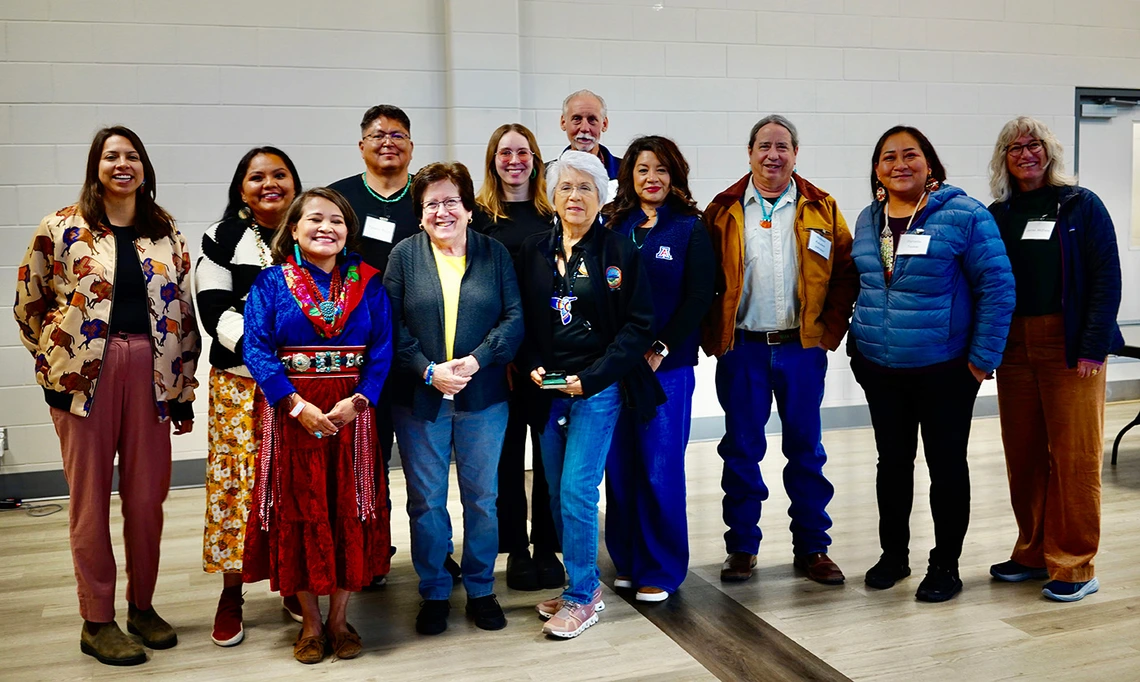Colorado River Basin Delegation Attends Workshop on Indigenous and Western Science

Members of the Colorado River Basin Delegation. From left: Mira Busch, Nikki Tulley, Karletta Chief, Tommy Rock, Sharon B. Megdal, Ruth Pannill, Chairwoman Amelia Flores, David DeJong, Christina Urbina Gargus, Michael Kotutwa Johnson, Ranalda Tsosie, Jamie McEvoy
Image: Jérôme Marty, Executive Director of the International Association for Great Lakes Research (IAGLR)
Last week, October 8–10, 2025, a delegation from the Colorado River Basin (CRB) traveled to Toronto, Ontario, Canada, to participate in a workshop on “Braiding Knowledges in Water & Land: Collaborative Adaptive Management.” WRRC Director Sharon B. Megdal and Dr. Karletta Chief (Diné), Director of the Indigenous Resilience Center at the U of A, were among the organizers of the workshop, which included representatives from the CRB, the Bay Delta region of California, Australia, and Canada. The 12-person delegation from the CRB included the Honorable Amelia Flores (Mohave), Chairwoman of the Colorado River Indian Tribes (CRIT).
The three-day workshop explored how Indigenous and Western science can work together to improve water and land management using an approach called Collaborative Adapative Management (CAM), which is guided by the Mi’kmaq principle of Two-Eyed Seeing — or using the strengths of both Indigenous and Western ways of knowing. The workshop started with a visit to the Six Nations of the Grand River reserve to learn about cultural practices and to give participants a sense of place in the traditional territory of the Mohawk, Cayuga, Onondaga, Oneida, Seneca, and Tuscarora Nations. The gathering opened with the Haudenosaunee Thanksgiving Address, which expressed appreciation for all life forms and gratitude for the space to unite participants’ minds and hearts in shared purpose and respect to address shared challenges in ensuring water and food security. The Honorable Sherri-Lyn Hill, the 59th Elected Chief of the Six Nations of the Grand River, welcomed the group and noted the importance of the topic of the workshop for her community, which is the most populous First Nation in Canada. The reserve, located just 60 miles southwest of Toronto, faces water boiling advisories; most residents rely on wells and their homes are not connected to regulated clean drinking water.
The subsequent two days of the workshop were held at the Native Canadian Centre of Toronto, which provides programs and services to empower the urban Indigenous community. Participants shared their experiences and insights on the topics of CAM, braiding knowledge systems, Indigenous leadership, and circular learning. Director Megdal provided an overview of the CRB, noting Tribal Nations and rivers in Arizona. Director Chief spoke about her approach to working with Diné communities to understand the exposure, risks, and risk perceptions of the 2015 Gold King Mine spill that affected the Navajo Nation and how this SNBH approach was analogous to a Diné CAM Approach. SNBH is an acronym for a fundamental Diné philosophy and epistemology that represents a holistic and cosmological framework for living a long harmonious and balanced life. Dr. Ranalda Tsosie (Diné), Assistant Professor at New Mexico Tech, emphasized the importance of building relationships based on trust, responsibility, respect, and reciprocity and also spoke about the Diné SBNH framework. Chairwoman Flores highlighted CRIT’s efforts to grant personhood rights to the Colorado River. The presentation by Dr. David DeJong, Director of the Pima-Maricopa Irrigation Project, featured the Gila River Indian Community’s (GRIC) solar-over-canal project.
Dr. Tommy Rock (Diné), Assistant Research Professor at Northern Arizona University, discussed the challenges of clean water access in Monument Valley Utah Park and remote, rural communities on the Navajo Nation, including his hometown of Oljato, UT, where roads can be flooded and impassable when people need to travel long distances to haul water. He spoke of the Diné philosophy of “nihaa áłchíní nihaandokah” which is the return of young people to help Diné communities after they receive their education, a philosophy that Chief Manuelito stated when he signed the Navajo Treaty of 1868. Dr. Rock noted that CAM frameworks in Indigenous communities are successful when researchers from their Tribes are leading the projects. There were also many other excellent presentations from other geographies.
Some key take-aways for successful CAM include: the importance of building relationships first; trust, respect, and reciprocity as key to relationships; ensuring that research practices are empowering and not extractive; recognizing Indigenous knowledge as a science; the need for supportive spaces in which to be vulnerable; acknowledgement of inter-generational trauma; and recognition of the incredible resilience and strength of Indigenous cultures and communities. The workshop was sponsored by the Australian Commonwealth Scientific and Industrial Research Organisation’s (CSIRO) AquaWatch Program, and the Foundation for Food & Agriculture Research (FFAR).

